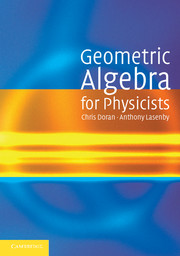Book contents
- Frontmatter
- Contents
- Preface
- Notation
- 1 Introduction
- 2 Geometric algebra in two and three dimensions
- 3 Classical mechanics
- 4 Foundations of geometric algebra
- 5 Relativity and spacetime
- 6 Geometric calculus
- 7 Classical electrodynamics
- 8 Quantum theory and spinors
- 9 Multiparticle states and quantum entanglement
- 10 Geometry
- 11 Further topics in calculus and group theory
- 12 Lagrangian and Hamiltonian techniques
- 13 Symmetry and gauge theory
- 14 Gravitation
- Bibliography
- Index
5 - Relativity and spacetime
Published online by Cambridge University Press: 05 January 2013
- Frontmatter
- Contents
- Preface
- Notation
- 1 Introduction
- 2 Geometric algebra in two and three dimensions
- 3 Classical mechanics
- 4 Foundations of geometric algebra
- 5 Relativity and spacetime
- 6 Geometric calculus
- 7 Classical electrodynamics
- 8 Quantum theory and spinors
- 9 Multiparticle states and quantum entanglement
- 10 Geometry
- 11 Further topics in calculus and group theory
- 12 Lagrangian and Hamiltonian techniques
- 13 Symmetry and gauge theory
- 14 Gravitation
- Bibliography
- Index
Summary
The geometric algebra of spacetime is called the spacetime algebra. Historically, the spacetime algebra was the first modern implementation of geometric algebra to gain widespread attention amongst the physics community. This is because it provides a synthetic framework for studying spacetime physics. There are two main approaches to the study of geometry, which can be loosely referred to as the algebraic and synthetic traditions. In the algebraic approach one works entirely with the components of a vector and manipulates these directly. Such an approach leads naturally to the subject of tensors, and places considerable emphasis on how coordinates transform under changes of frame. The synthetic approach, on the other hand, treats vectors as single, abstract entities x or a, and manipulates these directly. Geometric algebra follows in this tradition.
For much of modern physics the synthetic approach has come to dominate. The most obvious examples of this are classical mechanics and electromagnetism, both of which helped shape the development of abstract vector calculus. For these subjects, presentations typically perform all of the required calculations with the three-dimensional scalar and cross products. We have argued that geometric algebra provides extra efficiency and clarity, though it is not essential to a synthetic treatment of three-dimensional physics. But for spacetime calculations the cross product cannot be defined. Despite the obvious advantages of synthetic treatments, most relativity texts revert to a more basic, algebraic approach involving the components of 4-vectors and Lorentz-transform matrices.
- Type
- Chapter
- Information
- Geometric Algebra for Physicists , pp. 126 - 166Publisher: Cambridge University PressPrint publication year: 2003



